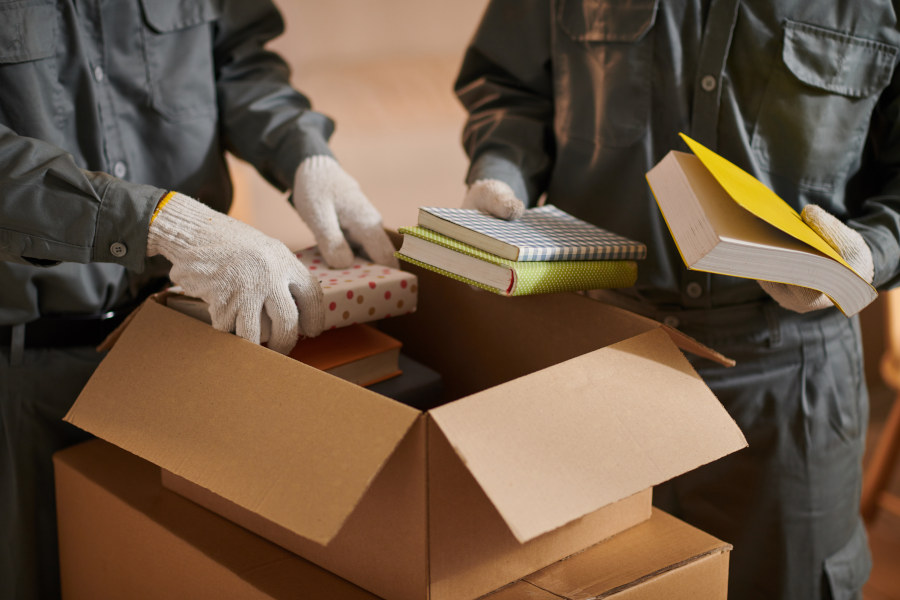
DO’S and DON’TS when packing and moving books
Moving to a new home can be quite exciting. You might be envisioning the happiness and new memories that you are going to create at the house or apartment of your dreams. And these are going to become a fact. First, however, you need to take care of some practical matters, such as packing and transporting your possessions to the home of your dreams. Books are rarely thought of as a challenging type of household goods to be relocated. That can’t be further from the truth, even if you have a relatively modest personal library. You need to make sure you wrap, pack, and transport your books properly if you want them to arrive in good condition at your new home. It doesn’t matter whether all your books are cheap paperbacks, or you have a collection of valuable antiques. You’d like them to be treated properly. So, let’s take a quick look at the dos and don’ts of moving books.
The DO’s of How to Pack Books
One thing few people think about when the question of getting books packed and moved is that they are actually pretty heavy. It doesn’t matter whether we are talking about the heaviest books and volumes in production, such as coffee books, photo albums luxury hardback editions with many pages and valuable antique books, or even pocket books in large quantities. Paper is a heavy material and your books are packed into packing boxes carefully and up to the highest standards. To secure the books further, use packing tape liberally to reinforce the bottoms and sides of the cardboard boxes, ensuring they can bear the weight without tearing. To do that, you need to make some preparations in advance.
Sort, Clean, and Prepare Books
Several days before your moving date, go through your book collection. Since this is a pleasant enough activity in its own right, especially for book lovers such as yourself, you might want to leave it for last, as a way to unwind and reward yourself for a job well done by navigating through the complicated process of preparing for your relocation.
Make sure that the floors are clean. You can even lay some packing paper on the floor to make sure nothing bad will happen to the book covers of your volumes. Before wrapping each book, consider using balled up packing paper to fill any voids in the boxes, providing additional cushioning. Sort your book collection, putting the antique books and more valuable volumes on one side. This is also a perfect time to decide which books to keep and which to donate, reducing the overall volume and weight of your move. You have a few options for sorting your books, including by size, though it might not be the best idea to pack all the heaviest books in the same box. The important thing to do now is to clean your books by removing the dust from the volumes using a soft cloth and gentle motions. Check if any of the books have any damage. You can even take notes about their condition to make sure that they arrive at your new home precisely as they left your old one. Book lovers generally take great pleasure in sifting through their book collections, so try to enjoy the process as much as possible.
The preparation stage is the time to get all the necessary packing supplies together as well. Consider using plastic bags to wrap delicate books, protecting them from moisture and dirt during the move. The packing boxes you have left from your other possessions might not be enough, or suitable to pack books in. There are special book boxes available, but you can just use smaller boxes of any kind to pack books for moving. Other things you might need are packing tape, bubble wrap, acid-free paper, and some corrugated cardboard. Adding packing peanuts into the mix can help fill empty space and provide additional padding around the books. When you look at your book collection, you may assess how many other boxes, box seams, and storage space you are going to need to ship your books. When moving house, every inch of space on the van matters, so you’d like to pack your books in as few small boxes as possible, while still making sure they are relatively easy to handle.
Choose the Right Boxes to Pack Your Books In
One of the best tips for packing books you can get is to never pack books in boxes that are too large. For hardcover books, pack boxes with the book standing upright to prevent bent covers and damaged bindings, ensuring the lighter books are at the top to avoid pressure on more delicate volumes. You might have great confidence in your upper body strength and the ability to properly pack a book box and bring it to the moving truck. There is one undisputed truth though, and that is that packed books are heavy. That is why you should choose boxes that are not only in the right shape to accommodate you when you pack books but are also on the smaller side. They will fit fewer books, but just the risk of a back injury from trying to lift bulky moving boxes should be enough to convince you.
If you are not much into moving boxes, you can pack books into rolling suitcases as well. Utilizing rolling luggage is especially effective for transporting heavy textbooks and large boxes of paperback books without straining your back. This is a particularly handy option if you have a relatively small book collection and a few suitcases to spare. Think of it as the equivalent of moving bulky furniture with a moving dolly.
Should books be packed flat or upright?
When you pack books for moving, you might wonder whether it is better to pack them upright or leave the books flat in the boxes. To pack hardcover books and protect them during the move, it’s advisable to lay them flat, ensuring their weight is evenly distributed and preventing any damage to their spines. To properly pack your books for moving, make sure that all the books are laid flat in the box. Upright packing is reserved for only smaller books or hardbacks that will not bend, but even then it’s better to leave them flat. Fill any space left with packing paper and/or bubble wrap to ensure that the books don’t move around in the box. Doing that makes sense if you want to avoid damaging the corners of the covers. Also, make sure you don’t pack books at odd angles. Your personal library should be free of damaged books once it arrives at your new place if you make sure to fill any extra space with paper. Use tape to close the box once you fill it, and label it with BOOKS using a marker.
When labeling, clearly distinguish between boxes containing lighter books and those with hardback books to aid movers in handling. The more books you have to move, the more careful you should be about labeling the boxes. It is one of the more important things that will help your movers and helpers identify your personal library among your other boxes and know how they should handle and arrange them.
The Don’ts of How to Pack Books
In addition to the good practices when it comes to the way you pack your books, there are some tips you need to have in mind when it comes to things to avoid when you pack books.
The most important thing is to avoid packing books spines up and spines down. In both cases, you risk damaging the spines and the bindings because of the weight of the pages.
Much in the same vein, you should never pack books too tightly. This will cause the covers to press against each other, leading to friction and damage. This is particularly important when it comes to packing antique and valuable books. Wrapping books individually or in small groups can prevent damage to delicate books, ensuring they are protected throughout the moving process. To pack books too loosely is also a bad idea and a practice you’d better avoid. If you don’t have enough books to fill a box, just wrap them with more packing paper and bubble wrap. For any remaining empty space, consider using lighter books or other lightweight items to ensure stability without adding excessive weight. If you run out of packing paper and bubble wrap for some of the last book boxes, you can improvise – stuffed animals and even clothes will secure your books for transportation just as well as the professional-grade packing supplies.
We already covered the part about packing too heavy. The logical continuation of this tip is that you should avoid stacking book boxes one over the other. If you run out of space and should do it anyway, make sure that you don’t put the heavier boxes on the light boxes. When storing books temporarily, keep the boxes in a dry, cool place to prevent any damage from humidity or temperature fluctuations. The weight will damage the cardboard and make it harder, if not outright impossible to handle.

Last but not least, check the weather forecast for your moving day. If it looks like rain, it might be a good idea to postpone moving your books for when the sky clears. Rain will damage the boxes and cause water and moisture to enter. Nothing ruins paper, and books in particular, as water.
About author
-

-
Jeremy Oliver
Previously serving as a logistics coordinator, Jeremy's comprehensive understanding of the industry gives him the ability to translate complex procedures into easy-to-understand blog posts. He has a particular knack for tackling the intricacies of London's removals scene, from the congested roadways to the unique challenges of navigating historic neighborhoods. As an authentic Londoner, Jeremy combines practical knowledge with his inherent love for the city, offering readers not only information on man with van removals but also local insights and valuable tips.

